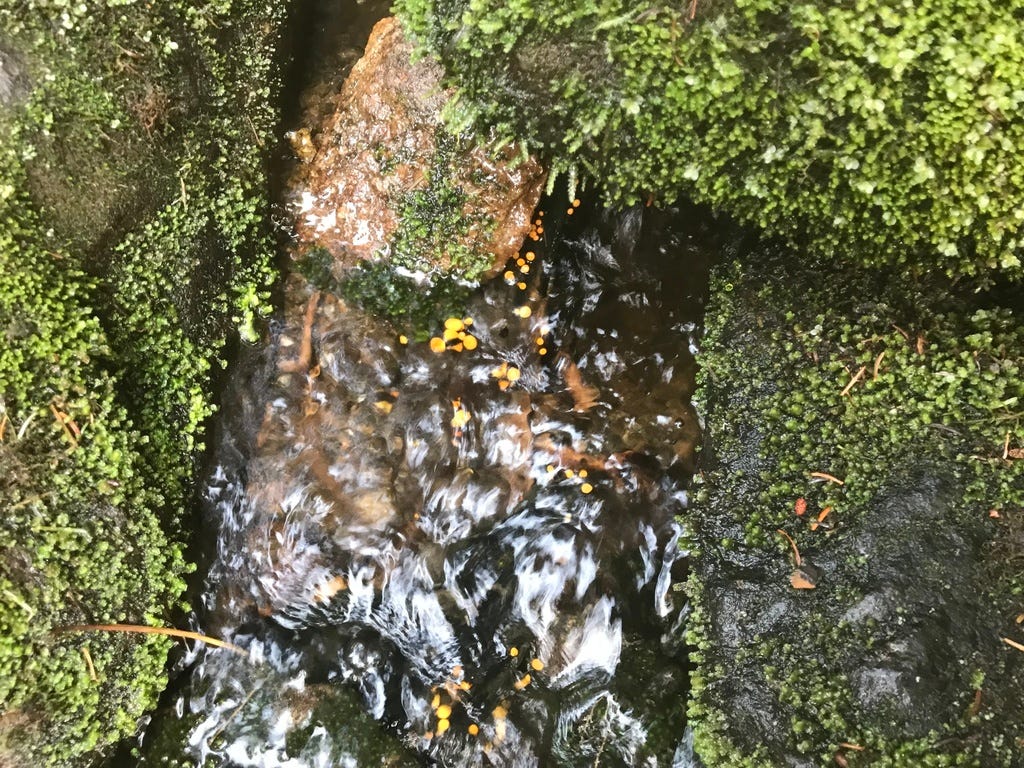Good evening, friends,
This week’s mushroom is a follow-up from last weekend in the White Mountains, the Water Club mushroom (Vibrissea truncorum). We saw them a handful of times throughout the weekend, always erupting from wood that was partially submerged in cold, fresh water. I'd seen them once before, also in the White Mountains, but I hadn’t thought of them much since then so let’s take a closer look.
Fun Facts
These mushrooms are semi aquatic (aero aquatic is the fancy term) and while the mushrooms can grow in water, they prefer to fruit above the waterline. Now this naturally leads you to wonder, “are there any fully aquatic mushrooms?”
Well, as of 2010 we now know that there is a gilled basidiomycete (a traditionally-shaped mushroom) that appears to grow and fruit entirely underwater. Psathyrella aquatica was found by a Southern Oregon University professor, Robert Coffan ,in 2010 in - you guessed it - Southern Oregon. It should be noted that there are several ascomycetes (a different phylum than basidiomycetes) that grow and fruit entirely underwater.
The first time we encountered these mushrooms I got excited and removed the submerged branch from the water to get some better photos. I handed the branch to Phil for him to check out and he pointed out some mold on the mushrooms as well. I hadn’t even noticed the mold, but upon closer inspection it did look like a whispy bread mold was growing on the majority of the mushrooms. A fungus growing on a fungus. I wonder what the relationship is, does the mold get their nutrients from the Vibrissea? Very neat to see.
Vibrissea comes from the latin vibrissa which means “whiskers”, or “hairs of the nose”. They did grow pretty densely on the log. Truncorum comes from truncus which means “trunk” or “lopped” - a reference to the abrupt, truncated shape of these mushrooms.
Ecology
The aero-aquatic V. truncorum is saprobic, and the clubs usually pop up on pieces of wood that are partially submerged in fresh water. They’re distinctly shaped, but in the same phylogenetic order as Swamp Beacons (Mitrula elegans) which you see at lower elevations. The fungus fruits in the spring and the spores are long enough that you can see them erupting from the orange head if you use a hand lens. The fungus can be found in cold streams at high elevation areas throughout the entire northern hemisphere.
The fungus is an ascomycete which means it shoots spores out of the fruiting body rather than relying on gravity to pull them out like most basidiomycetes. We have to imagine that’s advantageous, if not imperative, underwater.
Also, I’ve got a feeling that if people start sequencing these (looking at their DNA), there are probably several genetically distinct but physically similar species all identified as V. truncorum. The separation of continents and mountain ranges can contribute to today’s vocab word: speciation (defined by Nat Geo as when a group within a species separates from other members of its species and develops its own unique characteristics).

Other Sightings Around the Preserve





It’s still a relatively slow time for fungi, although I am starting to see some mycorrhizals (Russulas) start to pop up. We could use some rain to really get them going. Menla this weekend, still time to sign up here. I imagine the Catskills will have something for us to look at next week.
New moon on Thursday,
Aubrey
References:
https://www.mycoquebec.org/bas.php?tag=Vibrissea+truncorum&iumq=2597
Frank JL, Coffan RA, Southworth D. Aquatic gilled mushrooms: Psathyrella fruiting in the Rogue River in southern Oregon. Mycologia. 2010 Jan-Feb;102(1):93-107. doi: 10.3852/07-190. PMID: 20120233.
https://burkeherbarium.org/imagecollection/taxon.php?Taxon=Vibrissea%20truncorum
https://education.nationalgeographic.org/resource/speciation/









I love the fungi, yes definitely, as always...
But the opossum? 🥹🥰🥰🥰